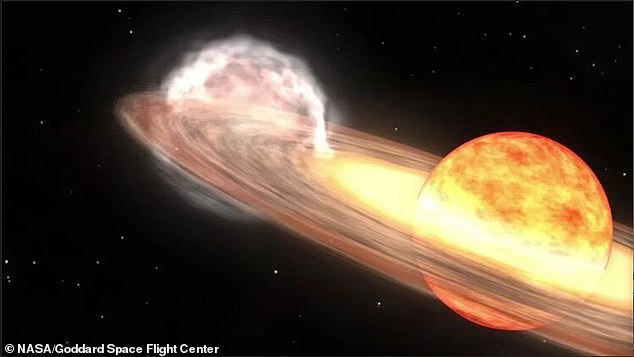A ‘zombie star’ could be resurrected on Halloween night, experts say.
T Coronae Borealis, also known as the ‘Blaze Star,’ is expected to explode any minute now. This will create a blast of light that will illuminate a dead binary star system for the first time in 80 years, according to NASA.
A binary star system is a pair of stars that are gravitationally bound to each other.
The Blaze Star is a white dwarf, which is essentially a dead star. It’s tied to a red giant, or a star that is in the last stages of its life.
The Blaze Star feeds off the red giant like a vampire, sucking hydrogen and other materials through its gravitational pull.
Eventually, it eats enough material to trigger a thermonuclear runaway explosion – a result of the buildup of pressure and heat.
This occurs roughly every eight decades, and causes the star to suddenly become extremely bright.
Normally, it isn’t visible to the naked eye. But when this explosion – or nova – ignites, it becomes as bright as the stars that form the constellations, a NASA expert said.

The Blaze Star is part of a binary system with a red giant star. Soon, it will explode in a nova similar to this illustration
It’s difficult to predict exactly when the nova will occur. But experts say it’s coming soon, and there’s a chance it could happen tonight – just in time for Halloween.
Once this zombie star rises from the dead, it will remain visible for about a week, NASA experts said.
To find it in the night sky, start by located the two brightest stars in the Northern Hemisphere: Arcturus and Vega.
Then, track a straight line from one to the other, a line that crosses Hercules and the Corona Borealis.
The Corona Borealis is to the right of Hercules and is roughly half way between Vega and Arcturus.
Look near the second star on the crown of the Corona Borealis to find where the Blaze Star should be.
This star was first spotted in 1217 when a German priest named Burchard of Ursperg observed ‘a faint star that for a time shone with great light,’ according to NASA.
The last time it was visible was in 1946.
Scientists will study the nova to learn more about what happens when stellar material is blasted from the white dwarf and distributed into neighboring galaxies, NASA astrophysicist Padi Boyd told ABC News.
That material is made up of carbon, nitrogen, oxygen, neon and other elements. Once it blasts out into interplanetary space, it will get gobbled up by other stars in the process of forming their own solar systems, Boyd said.
‘This is where that material in our own solar system — in our planet, in the oceans, in our bones, in our blood — those materials come from stellar explosions,’ she added.
This ‘once-in-a-lifetime’ event will also inspire young astronomers to ask new questions and collect their own data, Rebekah Hounsell, an assistant research scientist specializing in nova events at NASA’s Goddard Space Flight Center, said in a statement.
If the nova does take place tonight, it will add some festive flair to the night sky this Halloween.
This article was originally published by a www.dailymail.co.uk . Read the Original article here. .


